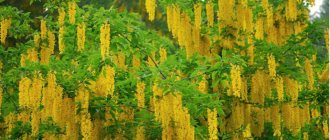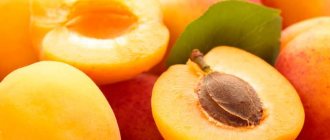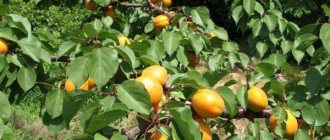When can an apricot tree be replanted?
There are several reasons why any fruit trees, including apricots, are replanted. Most often, this is a miscalculation when choosing the initial landing site. It is also possible to redevelop the garden, in which some elements remain in place, while others can still be regrouped. Sometimes the weather makes its own adjustments, forcing you to look for a more convenient place for the plant.
Replanting allows you to get a larger harvest, but at the same time shortens the life of the tree if done repeatedly
Replant three times?
There is an opinion that an apricot seedling needs to be replanted three times in order for it to bear fruit better. On the Internet you can find information that apricots grown from the seed also need to be replanted so as not to remain wild. Is it really?
If redevelopment, weather conditions or an initial miscalculation when choosing a location are serious reasons for replanting a tree, then opinions about replanting apricots three times for better fruiting and “ennobling” the variety have no logical basis. It must be remembered that replanting any plant is a serious operation that causes shock. Yes, after transplantation the apricot will indeed bear fruit more abundantly, but at the same time its lifespan will be shortened. After all, when digging, some parts of the roots are inevitably damaged, which negatively affects the condition of the seedling. And even though he easily and quickly takes root in a new place, his safety margin will inevitably decrease.
It is also useless to replant an apricot grown from a seed to a new place three times - it will remain wild in any case, unless you plant two or three good varieties on it.
In other cases, replanting allows you to find a new and final place for the plant, where there are all the necessary conditions for its growth and development.
Preparing apricots for transplantation
2-3 hours before the procedure, water the tree generously with warm water. Moisture is necessary so that the soil sticks to the roots and they are not damaged during transplantation. Dig a trench 60 cm deep around the plant, cut off the long roots with a shovel and place the apricot in burlap or a prepared bag.
Attention! Only healthy trees are suitable for replanting. They should not show signs of disease: spots, dry leaves, rot on the roots. It is recommended to carefully inspect all branches and leaves.
It is impossible to replant apricots “dry”: this will damage the weak roots of the plant and it will not take root well on the site.
Preparing the planting hole
The planting pit is prepared a month before transplantation. The soil is dug up using a shovel and all debris and plant debris are removed. If the ground was not watered with boiling water at the beginning of April, do it now to protect the apricot from pathogens and insect pests.
The width of the hole should be such that the entire crown of the tree fits into it, and the depth - all the roots. Fertilize the pit with a mixture of ammonium nitrate and superphosphate (200 g of each).
Choosing a time
Transplantation in autumn
Autumn replanting has the right to exist, provided that it is carried out at least a month before the first serious frost. In central Russia, this period begins on September 10 and ends on October 15–20. To replant the plant, you must wait until the dormant period begins - it begins after the leaves have completely fallen off. This will make it easier for the tree to withstand the procedure.
However, if autumn is dry, it is better to postpone the event to early spring.
Autumn planting gives the tree an advantage in terms of adaptation to climatic conditions
The main advantage of planting apricots in autumn is the gradual hardening that occurs with the first frost . As a result, by spring we will receive an apricot tree that is hardened and accustomed to local weather realities. At the same time, a timely planted plant has time to take root and strengthen over the winter, and in the spring it will begin to actively develop and grow.
Opponents of autumn transplantation argue that the wrong time in the fall can negatively affect the condition of the seedling . For example, it is undesirable to replant apricots during periods of strong warming, or too early, when there is too much time left before frost. The seedling can be damaged by cold weather, since in the first case there was a sharp temperature change, and in the second case it had time to get used to the warm regime and reacted poorly to the temperature drop.
Transplantation in spring
In spring, transplantation should be carried out before the buds swell, while the tree is still dormant. The main advantage of spring transplantation is the possibility of better survival of apricots due to warm temperatures. This can be argued, given the frequent return frosts. However, the truly positive aspect is the complete moisture of the soil that occurs after the snow melts. This condition will create more comfortable conditions for the seedling in a new location.
Spring replanting makes it possible to saturate the plant well with moisture and better take root in warm conditions.
But do not forget that an apricot transplanted in the spring will need periodic watering and will spend a significant part of the season on rooting and establishment. In addition, the plant will grow and develop in warm conditions, and with the onset of winter cold it may be at risk, being unprepared for such a change in weather.
Pros and cons
There are a variety of opinions regarding the time to transplant apricots. Some argue that autumn is preferable for tree survival, while others consider early spring to be a more reliable time. Judging from the point of view of adaptation to weather conditions, the autumn transplant looks preferable. Firstly, the apricot has time to undergo hardening before the onset of winter, and secondly, active development begins in the spring. The root system, which has taken root during the autumn-spring period, begins to fully provide all parts of the tree with the necessary nutrients. But it is worth remembering that all this happens only when the plant is planted in a timely manner, that is, when the period between transplantation and frost is not prolonged.
When planted in the fall, apricot grows faster and yields earlier
Mature fruit trees can be replanted even in winter, but provided that the air temperature is not lower than 5 degrees.
When is the best time to plant: spring or autumn
The procedure can be performed both in spring and autumn. But still, when is the best time to do this? Experienced gardeners agree that it is better to plant apricots in the southern regions in the fall, and in the more northern regions (Siberia, the Urals, Leningrad region) in the spring . At the same time, in the central zone (including in the Moscow region) you can do this both in the autumn and in the spring.
Replanting correctly
Preparing a seedling
3-4 hours before transplanting, the seedling is watered abundantly so that the soil moistens the root system and the soil near it. This way you will have the opportunity to dig up the roots covered, along with a lump of earth - this is much safer for them.
Of course, you can try and free the root system by making it open, but this must be done extremely carefully, preserving even the smallest roots.
We will consider a more labor-intensive, but more reliable transplant option.
The perimeter of the trunk circle (and it is approximately equal in diameter to the crown) is dug up, creating a small trench around the tree with a depth of 60–80 cm - this depth will allow the main roots of the apricot to be kept intact. Long roots are cut with a shovel. Then, using a fork or several shovels, pry up the root ball and move it onto cellophane or burlap prepared in advance. The material is wrapped and tied with an earthen lump so that it does not crumble. If the seedling needs to be transported over a long distance, it is better to place it after digging on a thick layer of sawdust.
Preparing the place
The planting pit for apricot is prepared in advance. For spring transplantation, it is dug in the fall, and for autumn transplantation, 3–4 weeks in advance. The top layer of fertile soil is set aside. The width of the planting hole should be almost twice the width of the crown so that the roots have maximum freedom, and the depth depends on the age of the tree and the branching of its root system .
The place for the pit is chosen on the south side of the garden - it must be protected from drafts.
Apricot loves loamy soils, but if the soil is too heavy, it will require a little work. In this case, drainage made of gravel and dry branches is placed at the bottom, after which it is covered with a layer of turf soil mixed with humus. The smaller the supply of nutrients in the soil, the wider the planting hole should be so that the roots have the necessary space for development.
The hole for transplanting apricots should be twice as wide in cross-section as the root system of the seedling
It is a good idea to add superphosphate (0.5 kg) and ammonium nitrate (0.2 kg) to the soil. If the soil is too acidic, also add 1 kg of lime. The soil is thoroughly mixed with fertilizers so that there is no direct contact of nutrients with the roots, otherwise the tree may get burned. For clay soil, use a mixture of red clay, sand and peat in a 1:1:1 ratio.
Process description
The seedling is placed in the hole strictly vertically, and if it has an open root system, then the roots are straightened along the entire length and they begin to fill it with earth. There is no need to compact it, just press it down to firmly fix the plant.
If you peel apricot roots when digging, save as many as possible to cause the least amount of damage to the tree.
After planting, create a roll of soil around the apricot without covering part of the root area. This roller will hold water when watering, preventing it from spreading. The tree needs to be watered generously. Subsequently, in the first summer season after transplantation, watering is carried out regularly, gradually reducing its intensity by the beginning of autumn, so that root growth slows down to a minimum by the onset of winter. It is necessary to supply the plant with water after harvesting in order to replenish all the energy spent on ripening the fruits.
Step-by-step instructions for planting a seedling
The scheme for planting apricots in spring or autumn is not particularly complicated. Every gardener, including beginners, can plant this crop on their plot without any problems. All you need is desire, hard work and knowledge of the key stages. Information about them is below:
Selecting a location
Comfortable growing conditions for apricots are very important. The yield, quantity and quality of fruits, and their taste properties depend on this.
An adult tree grows to a large size, its crown becomes spreading and wide, and the culture itself is heat-loving and light-loving. It is because of these features that the landing site must meet certain criteria:
- The place should be perfectly illuminated by the sun; the crop does not tolerate growing in the shade.
- The site is reliably protected from cold, northern winds.
- Moisture should not stagnate in the chosen location, and the groundwater level should be at least 3 m from the ground surface.
- The selected area should not be shaded by any buildings, trees, or shrubs.
- It is better to plant a tree on a hill; growing the crop in lowlands is not recommended.
- It is optimal to plant the crop on the south or south-west side of the garden; it is advisable that the tree is protected by a wall or fence on the north or north-west side.
Soil selection
The culture does not like dense soils. Loose, crumbly soil with good water and breathability properties is suitable for it. And also the soil must have a neutral or slightly alkaline reaction.
The best option is light chernozem soils, sandy loam, light loamy, medium loamy soils.
If your site does not have suitable soil for planting apricots, then you can correct the situation:
- if the soil is sandy, then you need to mix clay into it;
- and if it is clayey, then sand should be added.
Selection of seedlings
When choosing an apricot seedling, you need to give preference to varieties that grow normally in your climate zone. If you do not live in the southern region, then the variety must have good winter hardiness. In addition, in the northern regions it is important to plant early ripening varieties, otherwise the fruits simply will not have time to ripen.
Note! When choosing a seedling for your garden, be sure to ask the seller for information about the variety you are interested in; it should be suitable for growing in your region.
When choosing an apricot seedling, you should pay attention to certain parameters that will help you choose a good, healthy specimen:
- Age no more than 2 years.
- The height of the specimen is 1 or 1.5 meters, but no more.
- There should be a visible grafting site on the trunk.
- The root system of the plant is well developed, there is no damage, and there is also a main root and 2-3 lateral ones.
- The seedling should not show signs of wilting, damage, pests or diseases.
- The bark is healthy, without damage, cracks, its integrity is preserved.
- The central conductor is stronger and stronger than the lateral branches.
Important! The seedling must be in the dormant stage, otherwise when planted in the growing season, it may not take root or even die.
Video: how to choose a seedling.
Recommended distance
Since an adult tree is large in size and has a spreading crown, it is extremely important to follow the optimal crop planting pattern on the site.
The recommended distance between apricots is at least 5 meters. It is highly not recommended to reduce the distance, otherwise the trees will interfere with each other, and this will affect fruiting.
Preparing the planting hole
The site and planting hole should be prepared in advance. If planting is planned in the spring, then preparatory work should take place in the fall. And if you plant in the fall, it is better to prepare in the summer or spring. If you do not have the opportunity to prepare in advance, then do it at least a month or 2 weeks before the main work.
First of all, you need to prepare the planting site itself: dig up the area, remove debris, weeds, and level the soil. And after that you can start preparing the hole.
It is necessary to forge a landing hole 70 centimeters wide and 80 centimeters deep . At the same time, the soil from the top fertile layer must be thrown into a separate storage area. Place a drainage layer (10-15 cm thick) at the bottom of the recess; crushed brick can be used for this purpose.
Fertilizers should be applied three weeks before planting . They will serve as sources of essential nutrients that will stimulate adaptation and survival. You can add a mixture to the pit (three-quarters full) of the following ingredients:
- fertile soil from the top layer (two buckets);
- humus (one bucket);
- nitroammophoska (400 grams).
It is necessary to pour a small layer of fertile soil onto the fertilizer to make a slight elevation. Now water and leave for three weeks to allow the soil to settle.
Seedling preparation
In addition to the planting hole, you also need to prepare the seedling. A day before the gardening event, it is necessary to immerse the roots of the plant in clean water. Soaking activates biological processes.
Immediately before the procedure, it is recommended to dip the roots in a creamy mash (a mixture of water, manure and clay). Let the roots dry a little.
Planting scheme
The following step-by-step instructions will help you plant apricots correctly:
- Place the seedling in the hole and carefully straighten the roots. The root collar should be 5 centimeters above ground level.
- We fill it with soil, and you can shake the seedling a little so that the soil is evenly distributed between the roots.
- Drive a long peg into the side of the hole, which will be needed to support the young seedling.
- Now you need to compact the soil with your foot.
- We tie the seedling to the peg using twine.
- We make a circle around the trunk and water it thoroughly.
- The final step is mulching.
Apricot seedling
Replanting such a tree makes sense only if there is great need and only if the seed was planted immediately in open ground. A seedling initially grown at home, when transplanted outside, will simply die at the first cold weather. In addition, as we have already noted, the wild one will remain wild no matter how many times it is changed places, and each replanting only damages the suction parts of the roots and injures the tree, slowing down its growth.
An apricot grown from a seed is transplanted according to the same rules as a seedling from a nursery.
Otherwise, an apricot grown from a seed is no different from a purchased “thoroughbred” seedling. Therefore, it is transplanted according to the same scheme as described above.
Features of planting apricot trees in the regions
It is worth repeating that apricot is still a heat-loving plant, and no matter how great the success in breeding zoned varieties, planting apricot in areas in the middle zone, and especially in Siberia, is associated with considerable risk. In the southern regions, it is easy to grow apricots, especially on the fertile lands of Ukraine, Crimea or Kuban. However, with a lot of effort, it can be cultivated even in the Urals.
Somewhere there is an invisible border between areas where everything will definitely be fine, and where success is not guaranteed. This border is located somewhere at the latitude of the north of the Lower Volga region or Kharkov. North of this border there is always a risk. Freezing occurs often, and good harvests occur once every few years.
Planting apricots in the middle zone
Apricots have been planted in central Russia for quite some time, but previously they were only poles - semi-wild trees with small fruits. Recently, the assortment has expanded significantly; large-fruited varieties are also planted, but they must be grafted onto winter-hardy local rootstocks, perhaps sloe or cherry plum. The most popular varieties are Red-cheeked, Honey, Northern Triumph, Lel, Aquarius, Alyosha. , etc. They tolerate frosts well, and, most importantly, frequent thaws. The Eastern Sayan variety is also quite convenient for garden plantings, characterized by its compact size (no higher than 2.5–3 m), which makes it easier to care for.
One of the most popular varieties is Lel
In most areas of the middle zone, it is more reliable to place apricot seedlings on hills with a diameter of about 2 m and a height of up to 70 cm. Even the slightest lowlands are completely unsuitable for planting - cold air accumulates in them, as well as excess water, which is even more dangerous for apricots than frosts. If the site has a slope, it's okay. Only, no matter how strange it may seem, the slope should not be southern. And this is again due to the fact that apricot can withstand persistent frosts more easily than unexpected thaws. In addition, on southern slopes, seedlings will wake up earlier, which increases the risk of falling under return frosts. But the south side of the buildings is a good place. Moreover, sometimes summer residents even specially build some kind of light-colored shields so that the sun's rays warm up the apricot tree better.
The ideal soil is sandy loam, loam, but only with a neutral soil reaction. You don’t have to spare manure and ash, but it’s more convenient to use azofoska among mineral fertilizers. Otherwise, the landing is performed exactly as described above. Optimally - in early spring, always before the buds open. There are also lovers of autumn planting, but everyone chooses for themselves.
Planting apricots in the Moscow region
Of course, the Moscow region is also a middle zone. But the Moscow region stands apart in many matters. Even the high population density and abundance of industrial enterprises lead to the fact that the local climate is characterized by unpredictability. In winter, frosts are very often replaced by long thaws, and this is very bad for apricot trees: they lead to damping off of the roots and injury to them by the resulting ice crusts. During the winter thaw, if the air temperature rises to +5 oC, the trees come out of hibernation and begin active life, which then has an extremely negative effect on their condition. Only frost-resistant varieties that can withstand winter thaws are suitable for the region. The optimal areas for growing apricots in the Moscow region are the southern ones (Serpukhov, Chekhov, etc.).
The best rootstocks for apricot seedlings near Moscow are plum, sloe, and Manchurian apricot. Iceberg, Alyosha, Aquarius, Tsarsky are considered suitable varieties, but many gardeners are sure that the best is Lel . There is a practice of planting apricots on special clonal rootstocks.
Planting is carried out only in spring, if they do not have a closed root system. Apricots in the Moscow region, as well as throughout the middle zone, must be planted on a mound 1.5–2 meters wide. Instead of drainage, slate, metal sheets or other obstacles are often placed at the bottom of the hole. Apricot roots will not be able to grow through it and will be directed to the sides, which will protect them from the effects of groundwater.
The scheme for planting apricots on a hill involves fixing the seedling
The hill is sown on all sides with seeds of various herbs, maybe even spicy ones. As they grow, they are mowed down and left in place as natural mulch.
Planting apricots in Belarus
Belarus is characterized by wooded and marshy areas. There are almost no mountains here. The climate is characterized by sufficient humidity and relatively warm, as in the central regions of Russia. Of course, this is not the best region for growing apricots. It is mainly planted in the southern and southwestern regions (Gomel, Brest). In the northern regions, only the most winter-hardy local varieties are planted. However, prolonged winter thaws rarely occur in Belarus, and spring frosts usually occur after apricots bloom, so the trees bear fruit almost every year. Just don’t plant apricots in lowlands or drained peatlands.
Apricots are planted with seeds from local varieties and grafted ready-made seedlings. Grafting apricot cuttings onto winter-hardy thorn and plum trees is also practiced. Varieties traditional for the republic are developed by local scientists (Znakhodka, Pamyat Loiko, Spadchyna) . Varieties cultivated in Russia are suitable only for the southern regions.
In the south of Belarus, summer grafting of varietal eyes onto seedlings of local varieties is often practiced. In the first winter they are completely covered with earth. In other regions, they try to plant apricots as 1–2-year-old trees. Planting date is April. The landing technique is no different from the generally accepted one. However, in Belarus most soils are sandy. Therefore, a 20-centimeter layer of clay must be placed in the planting pits to retain moisture.
Apricot planting in the Urals
The territory of the Urals is a region with unstable weather and belongs to the zone of risky agriculture. Nevertheless, apricots are planted here too. In the Urals, it is possible to cultivate apricots provided they are planted in spring, but only fairly frost-resistant and unpretentious varieties. The most winter-hardy here are Amur, Seraphim, Minusinsk ruddy, Sibiryak Baikalova .
Apricot of the Seraphim variety - why not a southern fruit?
The main problem is not even freezing, but damping out of the root collar. It occurs at the end of February - beginning of March, when the snow begins to melt. Since the water constantly thaws and freezes again, it severely injures the cambium and, as a result, the tree slowly dies. Therefore, the peculiarities of apricot cultivation in the Urals are not even the planting technology itself, but the subsequent care of the seedlings. Already in November, if heavy snow falls within a radius of half a meter from the seedling, it must be removed. It’s better to let the ground freeze properly. The winter hardiness of the apricot root system is strong; it is practically not afraid of frost, unlike the ice crust in the soil. In March, the tree trunk circle is cleared of snow again.
The planting technique itself is common, but in the Ural region it is much safer to plant not apricot seedlings, but to grow trees from stones. To do this, several seeds are planted in the ground in the fall, they undergo natural stratification in the winter and sprout in the spring. Often the seeds are not even planted in shrubs, but immediately in a permanent place, in a pre-prepared planting hole. From several seedlings, the strongest is selected and cared for as if it were a real tree.
Video: replanting a fruit tree
Replanting an apricot is a responsible process that should not happen too often. It is advisable, in principle, to limit yourself to only one transplant, and even better, to immediately choose the right place for growing - this way the apricot will remain safe and sound and better adapt to local climatic conditions.
- Author: Evgeny Udaltsov
I love nature and the beauty of the world around me, I highlight this in my articles and try to help bring beauty to life. Rate this article:
- 5
- 4
- 3
- 2
- 1
(48 votes, average: 4.1 out of 5)
Share with your friends!
Optimal time for transplantation
The success of replanting a fruit tree directly depends on what time of year it was carried out. Experienced gardeners recommend starting this work while the plant is in a state of sleep. That is, in early spring. The optimal time is mid-autumn, before the snow has fallen and the first frosts have not arrived. If the summer resident manages to correctly determine the optimal moment for replanting, then the adult tree will not experience severe stress, which can have a detrimental effect on its adaptation to the new place.
The easiest time to replant apricots is in the autumn months. In this case, the tree will have a lot of time to get used to its new home. In order for the procedure to be successful, and for the plant to continue to develop normally, you will need to take care of insulating the seedling in advance. It should be covered with spruce branches, and the trunk should be protected with roofing material. A well-insulated tree is not afraid of any frost. Therefore, it will survive the winter without any problems. In spring, the first leaves will appear on the apricot, and it will begin to grow rapidly.
Unconventional methods of planting apricots
Depending on the climate, soil, and other factors, different planting methods can be selected:
- On the sand. It is sand that has excellent breathability, is lightweight and is well suited for growing apricots.
When planting an apricot using this method, place a layer of clay about 10 cm high at the bottom of the hole. Thanks to this technique, water will not quickly leave the soil and nutrients will not be washed out. After placing the seedling in the hole, add soil mixture (2 parts compost, 2 parts turf soil and 1 part sand). When apricot grows on sandy soils, the tree needs more frequent watering and regular fertilization. - According to the Zhelezov method. The plant should be planted as early as possible, after the frosts have ended, so that the apricot has time to grow before the start of winter. Before planting, place the seedling in cold melt or rain water overnight and leave it in a dark room. In the garden, create a seat - a gentle mound 20-60 cm high and about 2 m in diameter. The mound allows you to warm up the soil faster and protect the trunk and root collar from rotting. Place the seedling in the center of the hole, straighten the roots. No additional fertilizer required. Trim the seedling to almost half the crown. Cover the roots with soil and place fertilizer on top. Cover the seedling with a plastic bottle with a cut bottom and leave for 1 month.
- Planting two seedlings in one hole. Apricot can be planted in nests of several plants in one hole. For two seedlings, form a planting hole with a diameter of at least 100 cm. When planting, there should be a distance of about 30 cm between the seedlings. Then plant the trees in the same way as with the usual method. It is recommended to carry out nesting plantings at higher elevations, which is necessary for good ventilation and to prevent damping out of the trunk.
- Apricot grafting. Grafting can be done no earlier than the tree reaches 2 years of age.
Cut the trunk of the seedling at a level of about 8 cm from the ground and combine it with the cutting. For this purpose, use only young trees with a trunk thickness of at least 10 cm. In the spring, you can graft adult plants by implanting a cutting branch into the bosom. This method allows you to simultaneously grow several varieties of apricots on one tree, and the plant also begins to bear fruit much earlier. The optimal time for vaccination is considered to be from April to May.
Apricot seedling care
Caring for apricots after planting consists of several activities. You will need to protect the crop from pests and diseases. You must promptly remove all diseased branches and shoots, as well as collect diseased leaves and fruits for their subsequent disposal. It is also necessary to periodically carry out complete disinfection with chemicals and a solution of quenched soda.
Don’t be lazy, regularly remove dead and frozen bark. Periodically loosen the soil in the tree trunk area and remove weeds.
Advantages and disadvantages of spring planting apricots
Beginning gardeners do not know what period to choose for planting apricots. To make the right decision, you should familiarize yourself with the pros and cons of planting seedlings in spring.
The main advantages of planting apricots in spring are:
- Early planting allows the tree to grow a powerful root system and become stronger, making it much easier to endure the winter.
- It becomes possible to timely combat pests and drought, and the tree’s immunity is increased with the help of fertilizers.
- Before the beginning of winter, the planting hole will have time to settle, thereby preventing the root collar of the seedling from sinking.
The only disadvantage of planting apricots in the spring is considered to be the early growing season of the plant, because it is not always possible to carry out the procedure before the onset of frost.











